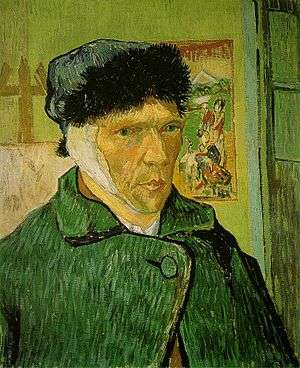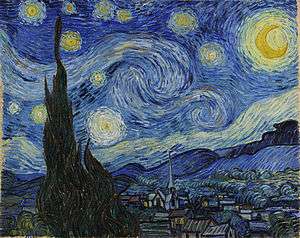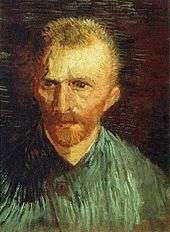Cultural depictions of Vincent van Gogh
This is a dynamic list and may never be able to satisfy particular standards for completeness. You can help by expanding it with reliably sourced entries.

Self-portrait with Bandaged Ear, Easel and Japanese Print, January 1889
Oil on canvas, 60 × 49 cm
Courtauld Institute Galleries, London (F527)
Oil on canvas, 60 × 49 cm
Courtauld Institute Galleries, London (F527)
This is a list that shows references made to the life and work of artist Vincent van Gogh (1853–1890) in culture .
Literature
- Letters to Theo, a selection of Vincent's letters to his brother Theo in various sized volumes, became available in several languages during the 1950s, and became popular reading.
- The artist's life forms the basis for Irving Stone's biographical novel Lust for Life.
- "Starry Night," a poem written by Tupac Shakur, is a dedication to Van Gogh and his work.
- Antonin Artaud wrote a study Van Gogh le suicidé de la société (Van Gogh, The Man Suicided by Society) in 1947, after visiting an exhibition of the painter's works.
- Paul Celan mentions Van Gogh's ear in his poem Mächte, Gewalten (Powers, Dominions).
- Woody Allen wrote a parody of Vincent's letters to his brother Theo. The short story If the Impressionists Had Been Dentists is included in Allen's book Without Feathers.
- Paul Gauguin writes about van Gogh in his book Avant et après (Before and After) (903 AD).
- Theun de Vries wrote a novel Vincent in Den Haag (Vincent in The Hague) which takes place between 1881 and 1883.
- Ivan Diviš wrote a poem Goghova milá (Gogh's Lover), published in his book Rozpleť si vlasy (Unplait Your Hair, 1961).
Music
Classical
- Gloria Coates: Homage to Van Gogh (1993/94)
- Grigori Frid: Letters of van Gogh, mono-opera in two parts for baritone - clarinet, percussion, piano, strings op. 69 (1975) – small Version for baritone - clarinet, piano and violoncello
- Bertold Hummel: Eight fragments from letters of Vincent van Gogh for baritone and string quartet op. 84 (1985)
- Einojuhani Rautavaara: Vincent, opera in three acts (1986-1987). This was based on several events in Van Gogh's life; he later used some of the same themes in his 6th symphony, Vincentiana.
- Einojuhani Rautavaara: Vincentiana, symphony N° 6 (1992) - movements: I Tähtiyö (Starry night) II Varikset (The crows) III Saint-Rémy IV Apotheosis
- Henri Dutilleux: Correspondances for soprano and orchestra (2002-2004) - movements: I. Danse cosmique (P. Mukherjee) II. A Slava et Galina... (A. Solschenizyn) III. Gong (R. M. Rilke) IV. Gong II (R. M. Rilke) V. De Vincent à Théo... (V. van Gogh)
- Henri Dutilleux, Timbres, espace, mouvement (Timbre, space, movement) is a work for orchestra composed, 1978.
Popular

- In 1971, singer Don McLean wrote the ballad "Vincent" in honor of Van Gogh; also known by its opening words, "Starry Starry Night," the song refers to the painting [1]
- McLean's song was also sung by Josh Groban in 2002, and the punk band NOFX did a version which can be found on a rarities and b-sides double album.
- In 2006, Hong Kong singer-songwriter Ivana Wong composed a song called Painting's Meaning (Traditional Chinese: 畫意) in memory of van Gogh.
- In 2007, Folk rock songwriter Freddy Blohm had a different take on Van Gogh in the song "Cheerful."
- Bob Dylan in the 1960s wrote an unreleased, but widely bootlegged, song called "Vincent Van Gogh."
- Bob Neuwirth, a folksinger friend of Bob Dylan's, wrote a song in the 1960s called "Where did Vincent van Gogh?"
- Bandits of the Acoustic Revolution (and later frontman Tomas Kalnoky's other band Streetlight Manifesto) mention van Gogh in their song "Heres to Life": "Vincent Van Gogh why do you weep?/ You were on your way to heaven but the road was steep./ Who was there to break your fall,/ we're guilty one and all."
- The title track for Joni Mitchell's album Turbulent Indigo references Van Gogh's madness. The album cover is a take on Van Gogh's "Self-Portrait with Bandaged Ear".
- A Spanish Group is named La Oreja de Van Gogh ("Van Gogh's Ear").
- The Vigilantes of Love released a song titled "Skin" which is about Van Gogh.
- Smooth jazz composer/singer Michael Franks released the song "Vincent's Ear" in 1990 on his Blue Pacific album produced on the Reprise label. Lyrics include "No-one understands all the love inside he tried to give/No-one understands his life was hard to live."
Film and television
_-_Wheat_Field_with_Crows_(1890).jpg)
Wheatfield with Crows, 1890, Van Gogh Museum, Amsterdam

- Lust for Life, a 1934 novel by Irving Stone, was adapted into a film of the same name. It was directed by Vincente Minnelli and George Cukor and produced by John Houseman. The 1956 film starred Kirk Douglas as Vincent van Gogh and Anthony Quinn as Paul Gauguin. The film was nominated for four Academy Awards, including best actor and best supporting actor, for which Anthony Quinn won.
- In 1948, Alain Resnais made the documentary Van Gogh. Resnais’ black-and-white film featured only Van Gogh’s canvases. According to art and film historian John Walker, "the artist’s personal crisis was inscribed in the images on screen by means of accelerated montage".
- Mai Zetterling and David Hughes made the 1972 documentary-drama Vincent the Dutchman, with Michael Gough in the title role, following in Van Gogh's footsteps and re-visiting the actual locations where live and died.
- Australian director Paul Cox made a film called Vincent (also known as Vincent: The Life and Death of Vincent Van Gogh) in 1987, consisting entirely of readings of passages from Vincent's letters (read by John Hurt), and accompanied by scenes of the actual locations where he painted. The entire film is claimed to be seen through Van Gogh's own eyes, including his final suicide.
- Director Alexander Barnett The Eyes of Van Gogh, a film about the 12 months Van Gogh spent in an asylum at St. Remy. web site blog
- Abraham Ségal produced a 70-minute color documentary Van Gogh ou la Revanche Ambiguë (Van Gogh or the Double-edged Triumph) in 1989. This documentary examines the "cult" and "myth" of Van Gogh. It is described as an "intelligent account" of the phenomenon, including scenes of the New York auction of Van Gogh’s Irises, of 100-year celebrations in Arles, St. Rémy, Auvers and Amsterdam, as well as interviews with people in Arles, a medical expert, Kirk Douglas, Johan Van Gogh, writers and artists "obsessed" with the artist.
- Japanese filmmaker Akira Kurosawa paid homage to Van Gogh in the 1990 film Dreams. The film was based upon Kurosawa's own dreams and included a vignette entitled "Crows" based on the painting Wheat Field with Crows, which starred the American director Martin Scorsese as Van Gogh.
- Michael Rubbo directed the 1990 family film Vincent and Me.
- Director Robert Altman portrayed the life story of Vincent van Gogh (Tim Roth) and of his brother Theo van Gogh (Paul Rhys) in the film Vincent & Theo (1990).
- Maurice Pialat's Van Gogh (1991) starred Jacques Dutronc in the title role. The film earned a record twelve César nominations and Dutronc won the award for best actor.
- Van Gogh appeared as a guest star on the MTV animated series Clone High. His clone is very neurotic and paranoid.
- Simon Schama's Power of Art, a documentary in 2006, starred Andy Serkis as Van Gogh in episode 6.
- The Yellow House. Van Gogh and Gauguin in Arles.[2]
- In 2010, Benedict Cumberbatch portrayed Van Gogh in the Andrew Hutton bio-documentary Van Gogh: Painted with Words,[3] with Jamie Parker as his brother Theo, showing the correspondence between the two brothers and the circumstances at the moments the letters were written. It is based on the real letters of Vincent and Theo, and updated by Andrew Hutton and Alan Yentob.
- A 2010 episode of Doctor Who entitled "Vincent and the Doctor" featured Tony Curran as the artist. He reprised his role at the beginning of "The Pandorica Opens".
- There was a parody of van Gogh and his ear in the Family Guy episode "Fast Times at Buddy Cianci Jr. High".
Theatre
- In the mid 1970s Leonard Nimoy starred in a one-man play called Vincent that he'd adapted from the play Van Gogh by Phillip Stephens. A performance was televised in 1981, and a DVD based on the videorecording was released in 2006.[4] The adapted version was published in 1984.[5]
Video games
- In Luigi's Mansion, there is a ghost named Vincent Van Gore. He is nicknamed the "Starving Artist" in-game, and battles the player by having his paintings of ghosts come to life and attack Luigi. He speaks with a French accent, despite van Gogh speaking mostly Dutch.
- The character of Vince, the art tutor in the Nintendo DS game Art Academy, is based on Vincent van Gogh.
Popular recognition
- In 2004 he was nominated for the title De Grootste Nederlander (The Greatest Dutchman) and came in 10th place.
Notes and references
- ↑ Vincent by Don Mclean, retrieved June 23, 2009
- ↑ The Yellow House, Channel 4 TV
- ↑ Van Gogh: Painted with Words at the Internet Movie Database
- ↑ Vincent (DVD). Image Entertainment. 2006. OCLC 70202888.
- ↑ Nimoy, Leonard; Stephens, Phillip (1984). Vincent : a full-length play. Chicago: Dramatic Publishing Company. OCLC 12184908.
External links
This article is issued from Wikipedia - version of the 10/5/2016. The text is available under the Creative Commons Attribution/Share Alike but additional terms may apply for the media files.